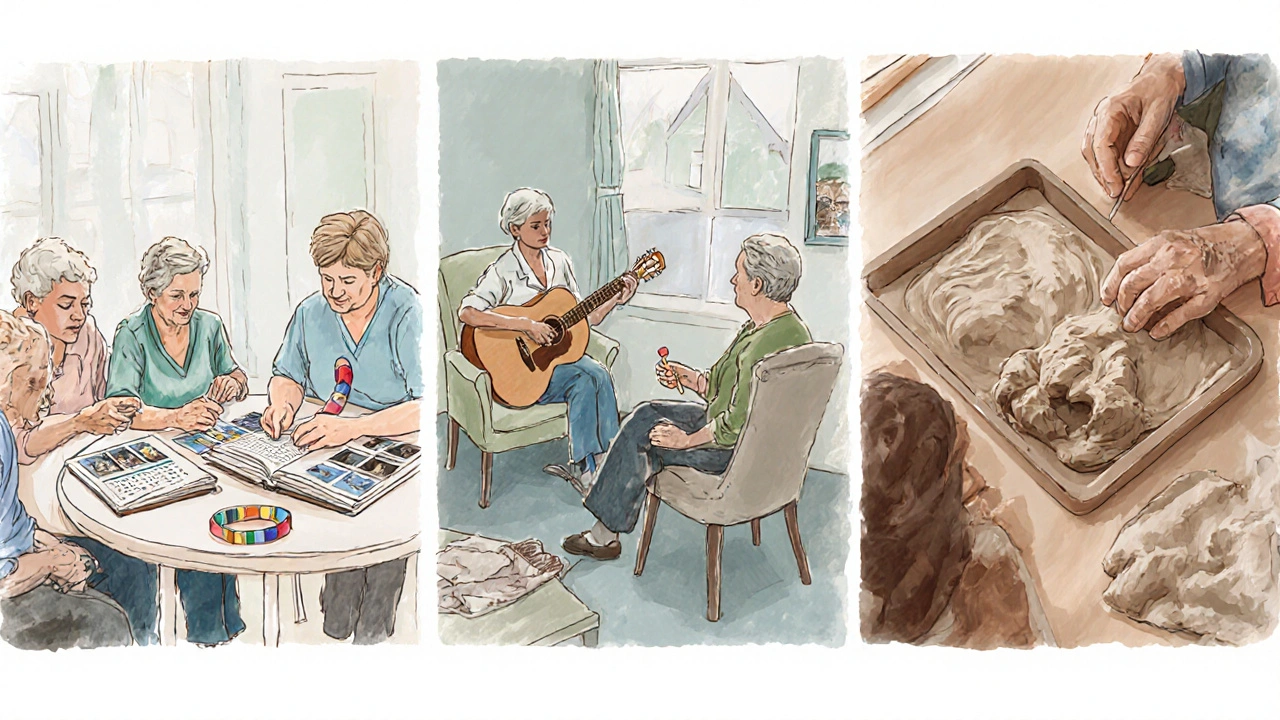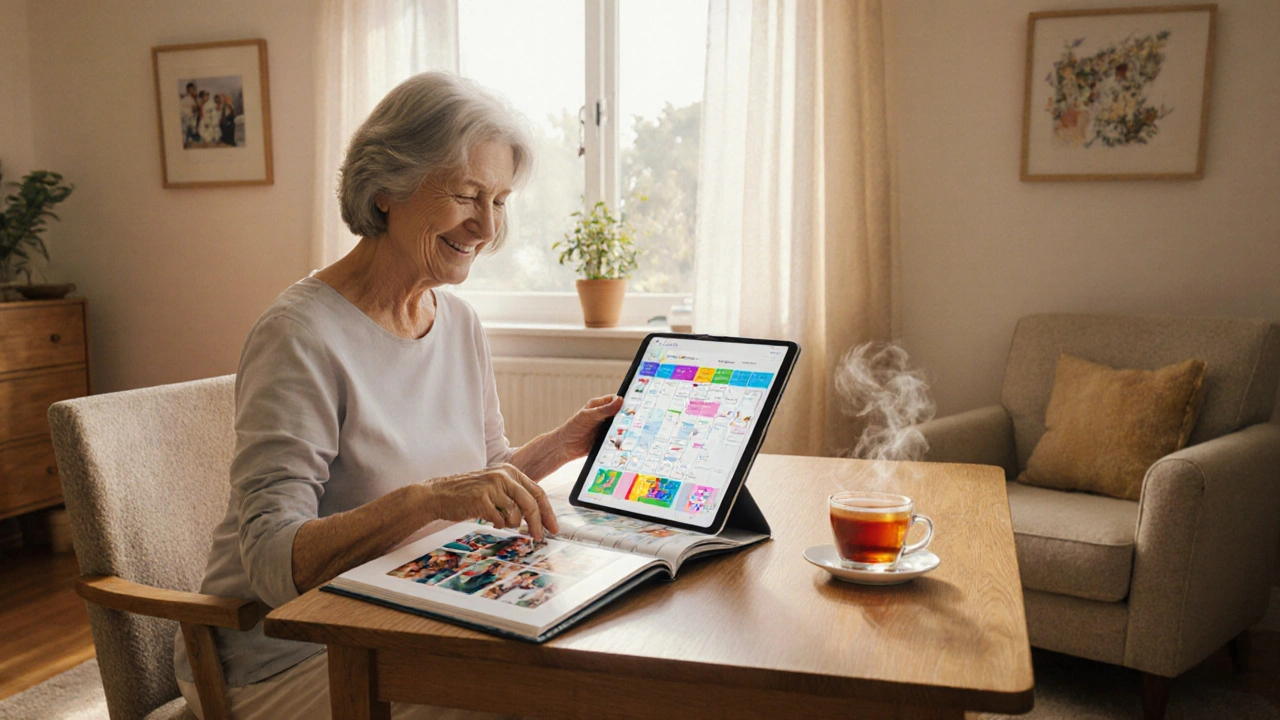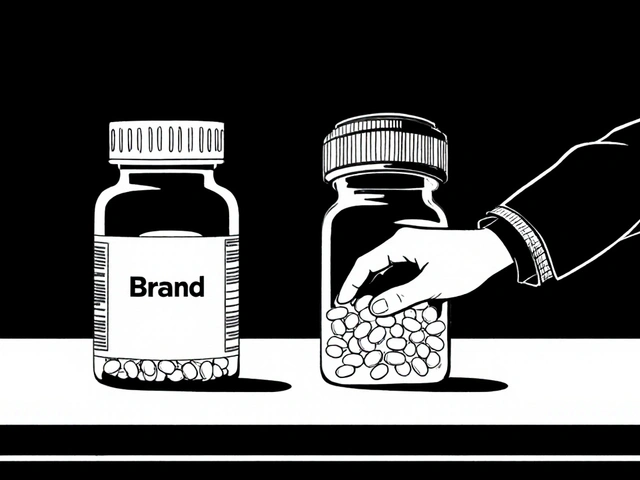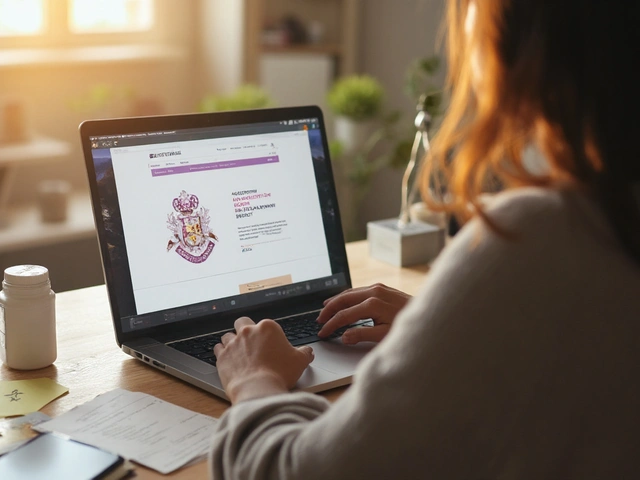Dementia Activity Planner
Recommended Activity Plan for
Based on and selected preferences:
Duration: minutes
Preferred Modality:
Selected Categories:
| Activity Type |
|---|
- Prepare the space with clear, safe pathways
- Provide gentle prompts without taking over
- Observe mood cues and engagement levels
- Keep a simple log to track progress
- Ensure all materials are easy to clean and durable
Finding the right things for someone living with dementia can feel like solving a puzzle without a picture. The goal isn’t just to fill time - it’s to spark joy, preserve identity, and keep the brain engaged. Below you’ll get a hands‑on guide that walks you through the why, the how, and the tweaks you’ll need as the condition changes.
Quick Takeaways
- Start with the person’s life story; use it to shape activity themes.
- Pick activities that balance familiarity with gentle challenge.
- Plan a flexible schedule: a core routine plus room for spontaneity.
- Involve caregivers early - they’re the bridge between intent and execution.
- Track simple cues (smile, engagement, agitation) to fine‑tune the program.
What Makes an Activity Meaningful?
Meaningful dementia activities are tasks that align with a person’s past interests, current abilities, and emotional needs, while also offering a modest cognitive boost. They differ from generic “busy‑work” because they honor identity and encourage connection.
Dementia is a progressive loss of memory, thinking, and reasoning caused by brain changes such as Alzheimer’s disease or vascular damage. Understanding the stage of dementia helps you match activity difficulty.
Key principles:
- Person‑centered - focus on who the individual was, not just what they can do now.
- Sensory‑rich - sight, sound, touch, and smell often stay strong longer than language.
- Simple goals - a successful finish (e.g., completing a puzzle piece) builds confidence.
- Safety first - eliminate hazards, keep furniture stable, and ensure good lighting.

Step‑By‑Step Planning Process
- Gather personal history. Talk to family, read old photo albums, note hobbies, favorite music, and cultural background.
- Assess functional level. Use simple checklists (e.g., can they button a shirt? can they follow a two‑step instruction?) to gauge motor and cognitive capacity.
- Select activity categories. Choose from reminiscence, music, art, physical, and cognitive‑stimulation options that fit the profile.
- Adapt materials. Larger buttons, textured objects, simplified instructions, or visual cues make tasks reachable.
- Build a weekly template. Reserve a consistent slot (e.g., 10am after breakfast) for a core activity, then add “mix‑ins” like a short walk or a song.
- Brief caregivers. Provide a one‑page cheat sheet: activity name, objective, steps, cues for success, and safety notes.
- Monitor and iterate. After each session, note mood, attention span, and any signs of frustration. Adjust difficulty or timing accordingly.
Adapting Activities to Dementia Stages
Each stage brings different strengths and challenges. The table below matches common activity types to mild, moderate, and severe dementia, highlighting preferred adaptations.
| Activity Type | Mild Dementia | Moderate Dementia | Severe Dementia |
|---|---|---|---|
| Reminiscence Therapy | Detailed memory prompts; photo albums with dates. | Simple cue cards; focus on emotions rather than facts. | One‑image cards; hand‑held objects (e.g., favorite scarf). |
| Music Therapy | Sing‑along with lyrics; instrument play. | Familiar tunes played softly; rhythmic hand‑clapping. | Passive listening; humming along with caregiver. |
| Art Therapy | Guided drawing with simple shapes. | Large‑brush painting; collage using pre‑cut pieces. | Texture exploration with clay or finger paints. |
| Physical Activity | Short walks with direction changes. | Seated marching; gentle chair yoga. | Hand‑to‑hand ball toss; guided stretching. |
| Cognitive Stimulation | Puzzle with 30-50 pieces; word games. | Large‑piece jigsaw; matching cards. | Simple cause‑and‑effect toys (e.g., button‑light). |
Involving Caregivers and Volunteers
Caregiver involvement is the linchpin for consistency. Their duties include:
- Preparing the space (clear clutter, set up materials).
- Providing gentle prompts without taking over.
- Observing mood cues (smile, eye contact, agitation).
- Recording brief notes for later review.
Training tips:
- Run a short demo (10minutes) before the first session.
- Give them a “cheat sheet” that lists key words to use (e.g., "Let’s try this together").
- Encourage them to share personal stories that can become future activity ideas.

Measuring Success and Tweaking the Plan
Formal assessments aren’t always needed; a simple observation chart works well.
- Mark the level of engagement (1=none, 5=fully involved).
- Note any signs of anxiety or agitation.
- Record the duration the participant stayed on task.
- After a week, tally averages - look for upward trends in engagement.
If scores dip, consider:
- Changing the time of day (morning may be easier).
- Switching to a more familiar activity.
- Reducing sensory overload (lower volume, softer lighting).
Pro Tips & Common Pitfalls
- Don’t over‑plan. One‑hour sessions become a marathon; aim for 20‑30minutes of active engagement.
- Use multisensory cues. Pair a photo with a scent (e.g., fresh coffee) to spark memory.
- Avoid “right‑or‑wrong” tasks. If a puzzle piece doesn’t fit, celebrate the effort instead of correcting.
- Rotate activities. Repeating the same game daily can breed boredom - keep a list of ten go‑to options.
- Listen for verbal and non‑verbal feedback. A sigh may signal fatigue even if they’re smiling.
Frequently Asked Questions
How often should activities be scheduled?
Aim for daily engagement, but keep each session brief (15‑30minutes). Consistency helps form routine, while short bursts prevent fatigue.
What if the person loses interest quickly?
Switch to a different sensory modality. If music wanes, try a tactile activity like folding soft towels. The goal is to stay in the moment, not force completion.
Can family members join the sessions?
Absolutely. Family presence adds emotional weight and often uncovers forgotten hobbies that can become new activities.
Do I need special equipment?
Most meaningful activities use everyday items - photographs, a radio, colored paper, or a chair. Choose sturdy, easy‑to‑clean objects and avoid anything that could break.
How can I track progress without formal tests?
A simple log noting engagement level, mood, and duration after each session provides enough data to spot trends and adjust the plan.






Christian Miller
One must consider the broader implications of any so‑called "activity planner" marketed to vulnerable populations, for it is often a façade for data collection that serves undisclosed corporate interests. The language used in the guide is deliberately optimistic, masking the likelihood that sensor‑based monitoring will be integrated without explicit consent. It is prudent to scrutinise the provenance of the suggested materials, as many are sourced from suppliers with undisclosed ties to pharmaceutical firms seeking to monetize patient engagement metrics. Moreover, the emphasis on "multisensory cues" conveniently aligns with emerging markets for proprietary aromatherapy kits, a sector notoriously opaque in its financial flows. In essence, while the framework appears benevolent, it may function as a conduit for surveillance capitalism, repackaged as compassionate care.
NORMAND TRUDEL-HACHÉ
Honestly, this guide reads like a textbook for the intellectually unchallenged. The advice is pedestrian, re‑hashing ideas that any competent caregiver should already know. If you’re looking for something beyond the obvious "play some music and hope for the best," you’ll be sorely disappointed. The language is simple for a reason - to avoid offending the faint‑hearted who cannot process nuance. In short, it’s a safe‑bet manual for the masses, but it lacks the sophistication that a true connoisseur of dementia care would demand.
AJIT SHARMA
It is disheartening to see a resource that merely scratches the surface while our nation grapples with a crisis of elder neglect. The guidelines, though well‑meaning, betray a complacent attitude that permits foreign cultural imports to dominate our traditional caregiving practices. We must champion indigenous activities that honour our heritage rather than succumbing to Western‑centric models. By doing so, we preserve dignity and resist the erosion of our cultural identity in the face of relentless globalization. The moral imperative is clear: prioritize home‑grown, family‑centric engagements.
Neber Laura
Nice effort but overcomplicated.
Karen Nirupa
Esteemed colleagues, I wish to extend my sincere appreciation for the thoroughness of this activity planner. The inclusion of sensory‑rich modalities showcases a profound respect for the residual strengths of individuals living with dementia. Moreover, the emphasis on safety and caregiver training reflects an admirable commitment to holistic well‑being. In my experience, such structured yet flexible frameworks foster meaningful engagement while preserving the dignity of participants. I encourage all practitioners to adopt these practices, adapting them with cultural sensitivity to honor each person’s unique narrative.
Quinn Comprosky
Reading through the guide, I find myself reflecting on the myriad ways we can honor each person's lived experience while providing a scaffold for daily engagement. When an elderly individual is presented with familiar melodies, the brain often lights up in unexpected ways, sparking moments of joy that ripple through the entire caregiving environment. It is essential to tailor these sessions, perhaps by integrating a cherished photograph alongside a beloved song, thus weaving visual and auditory cues into a single, resonant memory. Equally important is the gentle pacing of activities; rushed schedules can overwhelm and diminish the therapeutic impact, whereas a measured tempo invites calm participation. Caregivers should remain vigilant for subtle shifts in mood, noting a slight furrowed brow or a fleeting smile, and respond with compassionate affirmation. The inclusion of a concise log is a masterstroke, enabling families to track progress without imposing burdensome paperwork. Over time, patterns emerge, revealing which modalities sustain attention longest and which provoke agitation, allowing for nuanced adjustments. It is also worthwhile to involve volunteers who bring fresh energy, yet ensure they receive proper orientation to maintain consistency. In sum, the planner offers a robust foundation, but its true success lies in the empathetic application by those on the front lines, who translate guidelines into lived moments of connection.
By remaining adaptable, we honor the fluid nature of dementia, embracing both its challenges and its enduring capacity for love.
Thomas Ruzzano
While the guide presents a solid baseline, one cannot ignore the glaring omission of culturally specific music that resonates with diaspora communities. A vibrant playlist featuring traditional folk tunes could elevate engagement dramatically, yet the authors opt for generic western selections. This oversight betrays a subtle bias toward mainstream tastes, undermining the very personalization the guide purports to champion. Integrating regional instruments and rhythms would not only honor heritage but also stimulate neural pathways uniquely attuned to those sounds. In short, the planner would benefit from a broader, more inclusive auditory repertoire.
Dan Tenaguillo Gil
Friends, let me emphasize the transformative power of mentorship in implementing these activity plans. When a seasoned caregiver walks a newcomer through the setup of a reminiscence corner, the novice gains confidence that no checklist can provide. It is vital to foster an environment where questions are welcomed, and where the expertise of long‑standing volunteers is shared openly, never weaponized. By coupling clear, step‑by‑step instructions with lived anecdotes, we bridge the gap between theory and practice, ensuring that each activity is both safe and deeply meaningful. Additionally, documenting subtle successes, such as a fleeting smile during a tactile exercise, reinforces the value of perseverance. In this collaborative spirit, we can adapt the planner to diverse settings, from bustling urban centers to quiet rural homes, always honoring the dignity of the individuals we serve.
Tiffany Owen-Ray
Building on the mentorship point, I propose a reflective dialogue after each session, where caregivers articulate what resonated and what fell flat. This iterative feedback loop transforms the activity plan from a static document into a living philosophy, constantly refined by experience. By inviting caregivers to share personal stories that inspired a particular activity, we cultivate a rich tapestry of cultural narratives that deepen connection. Moreover, such reflective practice nurtures emotional resilience among staff, reminding them of the profound impact they wield. Let us therefore embed structured debriefs into the routine, ensuring that every moment of joy is amplified and every challenge is thoughtfully addressed.
Jill Brock
Wow, this guide is a rollercoaster of emotions! I can already picture the drama of a sudden breakthrough when a patient recognizes a song from their youth, followed by the heartbreaking moment when the memory fades again. The narrative tension is palpable, and the stakes feel incredibly high for both the caregiver and the person with dementia. It’s a true theater of the mind, where every cue can spark a scene worth a thousand words. The intensity of these moments makes the whole planning process feel like a high‑stakes performance, and I’m here for every twist and turn.
Ellie Chung
Let’s cut through the melodrama and get straight to the point: the guide needs more sparkle in its language! A dash of vivid metaphor could turn a bland “play music” suggestion into a vivid tapestry of sound that dances across the soul. By sprinkling color‑filled descriptors, we make the activities leap off the page and into the lived experience of participants. In short, fire up the prose, and the plan will ignite the hearts of both caregivers and patients.
Sophia Simone
Respectfully, I must disagree with the prevailing optimism of this document. While the authors champion flexibility, they neglect the rigorous evidence base required to substantiate each recommendation. A contrarian view would demand randomized controlled trials to verify efficacy, especially given the paucity of longitudinal data on multisensory interventions. Moreover, the narrative assumes a one‑size‑fits‑all approach, which, in my opinion, is intellectually lazy. A more skeptical stance would call for tailored protocols backed by measurable outcomes, not merely anecdotal anecdotes.
Juan Sarmiento
I hear your concerns and appreciate the call for rigor; however, let’s remember the human side of caregiving. Even modest, well‑intentioned activities can spark joy and reinforce identity, which are invaluable outcomes in themselves. While we strive for stronger data, the immediate practical benefits should not be dismissed. Let’s continue to share successes and refine our methods together, balancing evidence with compassion.
Patrick McVicker
Nice guide! 👍 It gives clear steps and real‑world tips. I think it’ll help a lot of families. 😊
Liliana Phera
While your enthusiasm is commendable, let’s not gloss over the ethical pitfalls of imposing activities without genuine consent. The philosophical underpinnings demand that we treat each individual as an autonomous agent, even when cognitive decline challenges traditional notions of consent. Aggressive enforcement of a schedule can inadvertently violate personal sovereignty, leading to subtle forms of coercion. Therefore, we must embed consent checks into every session, ensuring that the person’s agency remains central, lest we betray the very dignity we aim to preserve.
Dean Briggs
From a collaborative standpoint, integrating diverse perspectives enriches the activity planning process. By inviting input from occupational therapists, family members, and even the residents themselves, we construct a more holistic framework that respects varied expertise. This democratic approach not only enhances the relevance of chosen activities but also fosters a sense of ownership among all stakeholders. When each voice is heard, the resulting schedule becomes a tapestry woven from shared experience, ultimately leading to higher engagement and satisfaction. Let us therefore champion inclusive dialogue as the cornerstone of effective dementia care.
Sadie Speid
Excellent points, Dean. To add, precise documentation of activity duration and participant response is essential for continuous improvement. Accurate records enable us to identify trends, adjust difficulty levels, and ensure that each session remains both safe and stimulating. Practicing meticulous note‑taking also upholds professional standards and demonstrates respect for the individuals we serve.
Sue Ross
I’m curious about how the recommended sensory cues might differ across cultural contexts. Have caregivers observed variations in response to certain scents or sounds based on regional traditions? Exploring these nuances could further tailor the planner to diverse populations.